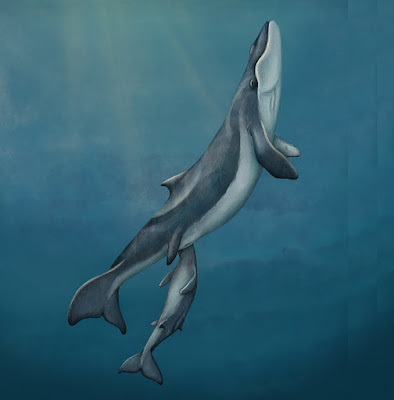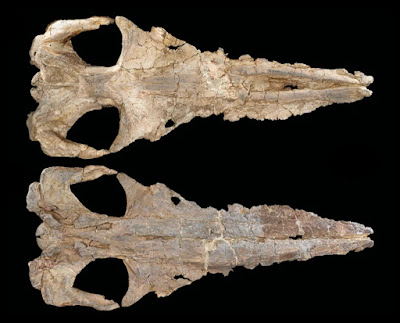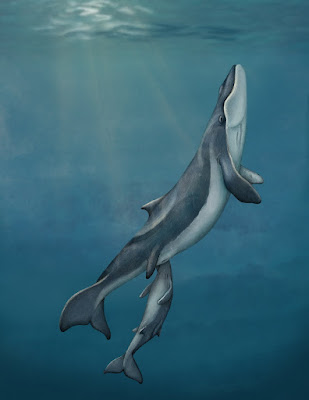|
|
| Пишет Species New to Science ( @ 2018-12-01 13:55:00 |
|
|
|
|
|
|
|
|
|
|
|
|
|
|
[PaleoMammalogy • 2018] Maiabalaena nesbittae • Tooth Loss Precedes the Origin of Baleen in Whales
 |
| Maiabalaena nesbittae Peredo, Pyenson, Marshall & Uhen, 2018 |
Highlights
• Maiabalaena nesbittae is 33 million year old fossil baleen whale from Oregon
• Maiabalaena has neither teeth, nor baleen
• Early whales lost teeth entirely before the evolutionary origin of baleen
• Despite no teeth or baleen, these whales were effective suction feeders
Summary
Whales use baleen, a novel integumentary structure, to filter feed; filter feeding itself evolved at least five times in tetrapod history but demonstrably only once in mammals. Living baleen whales (mysticetes) are born without teeth, but paleontological and embryological evidence demonstrate that they evolved from toothed ancestors that lacked baleen entirely. The mechanisms driving the origin of filter feeding in tetrapods remain obscure. Here we report Maiabalaena nesbittae gen. et sp. nov., a new fossil whale from early Oligocene rocks of Washington State, USA, lacking evidence of both teeth and baleen. The holotype possesses a nearly complete skull with ear bones, both mandibles, and associated postcrania. Phylogenetic analysis shows Maiabalaena as crownward of all toothed mysticetes, demonstrating that tooth loss preceded the evolution of baleen. The functional transition from teeth to baleen in mysticetes has remained enigmatic because baleen decays rapidly and leaves osteological correlates with unclear homology; the oldest direct evidence for fossil baleen is ∼25 million years younger than the oldest stem mysticetes (∼36 Ma). Previous hypotheses for the origin of baleen are inconsistent with the morphology and phylogenetic position of Maiabalaena. The absence of both teeth and baleen in Maiabalaena is consistent with recent evidence that the evolutionary loss of teeth and origin of baleen are decoupled evolutionary transformations, each with a separate morphological and genetic basis. Understanding these macroevolutionary patterns in baleen whales is akin to other macroevolutionary transformations in tetrapods such as scales to feathers in birds.
Keywords: baleen, cetacea, filter-feeding, mysticeti, suction feeding
 |
| Figure 1. Cranial Elements of the Holotype of Maiabalaena nesbittae, USNM 314627. |
Systematics
Cetacea; Pelagiceti;
Neoceti; Mysticeti;
Maiabalaena nesbittae gen. et sp. nov.
Etymology: Maiabalaena combines Maia-, meaning mother, and -balaena, meaning whale. Named for its phylogenetic position as basal to baleen-bearing mysticetes. The specific epithet nesbittae honors Dr. Elizabeth A. Nesbitt for her lifetime of contribution to paleontology of the Pacific Northwest and her mentorship and collegiality at the Burke Museum of Natural History and Culture in Seattle, Washington, USA.
 |
| 3D models of select specimens in lateral view with artistic reconstructions of their feeding modes: (B) Basilosaurus isis; (C) Coronodon havensteini; (D) Maiabalaena nesbittae; and (E) Balaenoptera musculus. These panels illustrate the loss of a functional dentition, the intermediate phase with neither teeth nor baleen, and the subsequent origin of baleen. Illustrations are original artwork by Alex Boersma (www.alexboersma.com). |
 |
| Figure 2. Phylogenetic Relationships of Stem Mysticetes Illustrating the Evolutionary Loss of Teeth and Subsequent Origin of Baleen Figure illustrates a composite phylogeny including results from this analysis (Figure S4) and recently published analyses. (A) Time calibrated simplified phylogeny, with collapsed clade resolution for Mammalodontidae, Aetiocetidae and Eomysticetidae, and crown Mysticeti. (B–E) Colored bars indicate groups figured; gray bars indicate groups not figured. Panels (b–e) represent 3D models of select specimens in lateral view with artistic reconstructions of their feeding modes: (B) Basilosaurus isis; (C) Coronodon havensteini; (D) Maiabalaena nesbittae; and (E) Balaenoptera musculus. These panels illustrate the loss of a functional dentition, the intermediate phase with neither teeth nor baleen, and the subsequent origin of baleen. Illustrations are original artwork by Alex Boersma (www.alexboersma.com). |
Carlos Mauricio Peredo, Nicholas D. Pyenson, Christopher D. Marshall and Mark D. Uhen. 2018. Tooth Loss Precedes the Origin of Baleen in Whales. Current Biology. DOI: 10.1016/j.cub.2018.10.047
Whales Lost Their Teeth Before Evolving Hair-like Baleen in Their Mouths si.edu/newsdesk/releases/whales-lost-the
Toothless, 33-Million-Year-Old Whale Could Be an Evolutionary ‘Missing Link’ gizmodo.com/toothless-33-million-year-ol





